- Author: Kathy Keatley Garvey
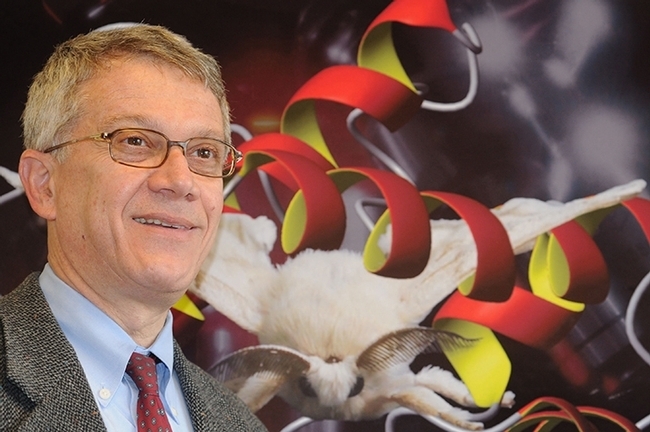
Leal, a leading global scientist and inventor in the field of insect olfaction and communication and known for his impact in the fields of molecular, cellular biology and enotmology, received his medal at a June ceremony in Phoenix.
NIA selected him an NAI Fellow in 2019. However, the COVID pandemic cancelled the 2019 ceremony in Phoenix. Then in 2020, travel restrictions interfered with his plans to attend the Tampa, Fla., ceremony. Elected Fellows are required to attend the induction ceremony within two years of election in order to receive their award.
Leal attended the ceremony with his wife, Beatriz; daughter Helena; and son Gabriel. Both have co-authored papers in the Leal lab, "so they represent all visiting scholars, collaborators, postdocs, project scientists, graduate students, and undergraduate students in my lab," he commented. (See video of the awarding of the medals)
NAI singles out outstanding inventors for their “highly prolific spirit of innovation in creating or facilitating outstanding inventions that have made a tangible impact on the quality of life, economic development, and welfare of society.” Election to NAI Fellow is the highest professional distinction accorded solely to academic inventors. The NAI Fellow program has 1,403 Fellows worldwide representing more than 250 prestigious universities and governmental and non-profit research institutes.
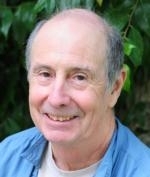
Leal is the second faculty member affiliated with the Department of Entomology and Nematology to be selected an NAI fellow. Distinguished professor Bruce Hammock, who holds a joint appointment with the Department of Entomology and Nematology and the UC Davis Comprehensive Cancer Center, received the honor in 2014.
Leal, an expert in insect communication investigates how insects detect odors, connect and communicate within their species; and detect host and non-host plant matter. His research, spanning three decades, targets insects that carry mosquito-borne diseases as well as agricultural pests that damage and destroy crops. He and his lab drew international attention with their discovery of the mode of action of DEET, the gold standard of insect repellents.
He and his collaborators, including Nobel Laureate Kurth Wuthrich (Chemistry 2002), unravel how pheromones are carried by pheromone-binding proteins, precisely delivered to odorant receptors, and finally activated by pheromone-degrading enzymes.
That led to Leal's identification of the sex pheromones of the navel orangeworm (Amyelois transitella), a pest of almonds, figs, pomegranates and walnuts, the major hosts. This has led to practical applications of pest management techniques in the fields.
At the time of his election to NAI Fellow, Joe Rominiecki, communications manager of Entomological Society of America (ESA), said Leal has “greatly advanced scientific understanding of insect olfaction. He has identified and synthesized several insect pheromones, and his collaborative efforts led to the first structure of an insect pheromone-binding protein."
ICE Council. Leal was recently elected chair of the International Congress of Entomology Council, which selects a country to host the congress every four years and which supports the continuity of the international congresses of entomology. Leal succeeds prominent entomologist May Berenbaum of the University of Illinois, Urbana-Champaign, editor-in-chief of the journal, Proceedings of the National Academy of Sciences and a 2014 recipient of the National Medal of Science.
“I have big shoes to fill,” he said.
Leal's name is currently on the ESA ballot to become an Honorary Member, the highest ESA honor. The Royal Entomological Society named him an Honorary Fellow in 2015.
A native of Brazil, educated in Brazil and Japan, and fluent in Portuguese, Japanese and English, Leal received his master's degree and doctorate in Japan: his master's degree at Mie University in 1987, and his doctorate in applied biochemistry at Tsukuba University in 1990. Leal then conducted research for 10 years at Japan's National Institute of Sericultural and Entomological Science and the Japan Science and Technology Agency before joining the faculty of the UC Davis Department of Entomology in 2000. He chaired the department from July 2006 to February 2008.
Leal co-chaired the 2016 International Congress of Entomology meeting, "Entomology Without Borders," in Orlando, Fla., that drew the largest delegation of scientists and experts in the history of the discipline: 6682 attendees from 102 countries.
Among his many other honors, Leal is a Fellow of ESA, the American Association for the Advancement of Sciences and the California Academy of Sciences. He is a past president of the International Society of Chemical Ecology and corresponding member of the Brazilian Academy of Sciences. In 2019, ESA selected him to present its annual Founders' Memorial Lecture, the first UC Davis scientist selected to do so.
This year Leal received the UC Davis Academic Senate's Distinguished Scholarly Public Service Award for his series of four global webinars educating the public about COVID-19. The online symposiums drew more than 6000 viewers from 35 countries. Hammock, who nominated Leal for the award, praised his “extraordinary spirit of public service and selflessness in creating, organizing, and moderating a series of four COVID-19 symposiums at the beginning of the COVID-19 pandemic. He spearheaded public awareness, helped educate the public, eased concerns, and translated the scientific data into lay language. His symposiums drew global attention and brought prestige to UC Davis. It was a crucial time in our history.”
In addition to research and public service, teaching is another of Leal's passions. The UC Davis Academic Senate selected him for its 2020 Distinguished Teaching Award for Undergraduate Teaching, and the College of Biological Sciences singled him out for its 2022 Faculty Teaching Award.
"I don't teach because I have to," Leal recently said. "I teach because it is a joy to light the way and to spark the fire of knowledge."
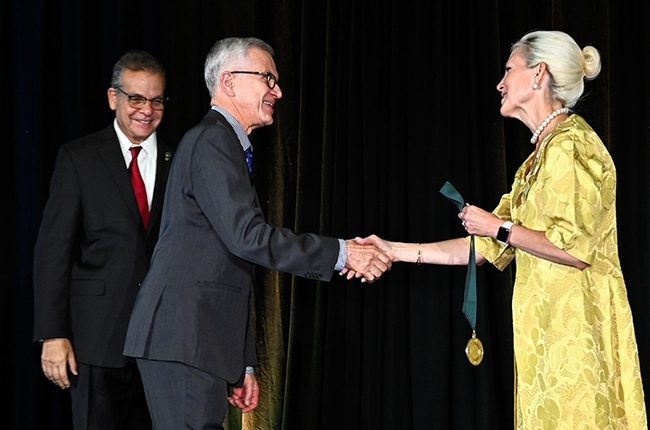
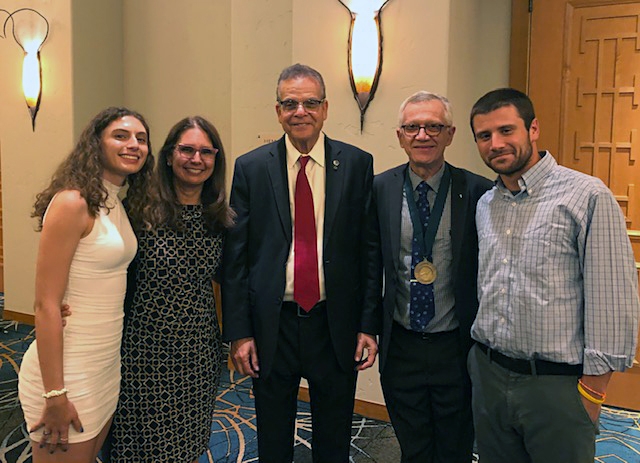
- Author: Kathy Keatley Garvey
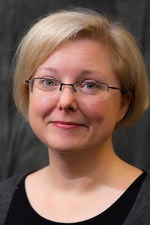
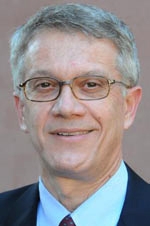
- Walter Leal, distinguished professor, Department of Molecular and Cellular Biology and former chair of the Department of Entomology (now the Department of Entomology and Nematology
- Cristina Davis, the Warren and Leta Geidt Endowed Professor and Chair, Department of Mechanical and Aerospace Engineering
NIA honors and encourages academic inventions that benefit society. Between the two UC Davis faculty members, they hold 42 patents: Davis with 12; and Leal with 28 Japanese and 2 U.S. patents.
Davis is a world leader in trace chemical sensing, while Leal is a leading global scientist in the field of insect olfaction and communication, investigating how insects detect odors, how they detect host and nonhost plant matter, and how they communicate within their species.
Leal's research, spanning three decades, focuses on insects that carry mosquito-borne diseases as well as agricultural pests, such as the Asian citrus psyllid and the orange navelworm. He and his lab drew international attention with their discovery of the mode of action of DEET, the gold standard of insect repellents.
We remember when Leal and a group of 18 students hosted a Zika Public Awareness Symposium in 2016 on the UC Davis campus. It was an amazing symposium that drew attention to Aedes aeqytpi, which transmits the disease. Soon thereafter, Brazilian-born Leal and his colleagues in Brazil, detected the Zika virus in wild-caught Culex quinquefasciatus mosquitoes in Recife, the epicenter of the Zika epidemic.
We also remember when Leal identified the sex pheromones of the navel orangeworm (Amyelois transitella), a pest of almonds, figs, pomegranates and walnuts, the major hosts. This led to practical applications of pest management techniques in the fields.
Those are just several examples of the work he does. And still, he found time to co-chair the 2016 International Congress of Entomology meeting, "Entomology Without Borders," in Orlando, Fla., that drew the largest delegation of scientists and experts in the history of the discipline: 6682 attendees from 102 countries.
We're not sure how Leal can find the time to do all this (see news story on the UC Davis Department of Entomology and Nematology). We figure he must have a clone! Make that multiple clones!
At any rate, Leal is the second faculty member affiliated with the entomology department to be selected an NIA fellow. The other scientist: Bruce Hammock, distinguished professor, who holds a joint appointment in the Department of Entomology and Nematology and the UC Davis Comprehensive Cancer Center. Hammock is the co-founder and chief executive officer of EicOsis LLC, a Davis-based company that is developing a non-opiate drug to relieve inflammatory pain in companion animals and target chronic neuropathic pain in humans and horses.
As Hammock said: “When Walter Leal reached UC Davis (in 2000), he came with the reputation of being a 'one man army in research.' This reputation was well deserved. I know of no one at UC Davis who matches Walter in taking his remarkable fundamental advances in science and translating them to increase the safety and magnitude of world food production.”
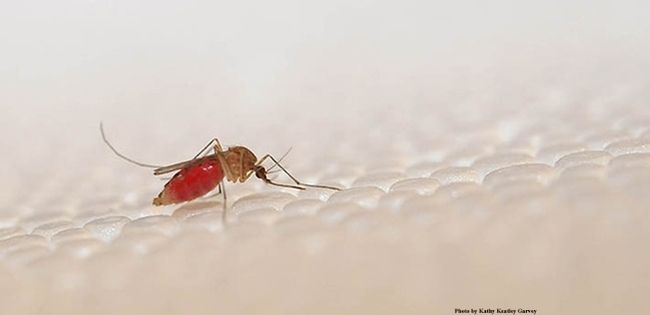
- Author: Kathy Keatley Garvey


Research lab, yes. With colleagues, postdoctoral researchers, graduate students and undergraduate students, yes.
Hammock, a distinguished professor of entomology at UC Davis who holds a joint appointment with the UC Davis Comprehensive Cancer Center, has just been selected a fellow of the National Academy of Inventors (NAI), which honors academic invention and encourages translations of inventions to benefit society.
He is now one of five UC Davis NAI fellows, including Chancellor Linda P. B. Katehi, who was inducted in 2012; Jerry Woodall in 2013; and Kyriacos A. Athanasiou and M. Saif Islam), both elected this year with Hammock in the 170-member Class of 2014 fellows.
A member of the UC Davis faculty since 1980, Hammock has made major innovations in multiple fields. Most recently his laboratory found potent enzyme inhibitors that dramatically reduce inflammation, inflammatory pain and neuropathic pain. He is the founder and CEO of EicOsis, and through EicOsis, the compounds are in clinical trials for companion animals and the Pre-Investigational tional New Drug Application (Pre-IND) Consultation Program for neuropathic pain in human diabetics. Hammock is developing both enzyme inhibitors and natural products as drugs for use in the United States and developing countries. In agriculture, his laboratory developed the first recombinant viruses as greeninsecticides, while in environmental chemistry, they pioneered the use of immunodiagnostics for environmental analysis and biosensor development, currently applying alpaca nanobodies to sensor technology.
Hammock is a member of the U.S. National Academy of Sciences, a fellow of the Entomological Society of America, and the recipient of the Bernard B. Brodie Award in Drug Metabolism, sponsored by the America Society for Pharmacology and Experimental Therapeutics. He directs the campuswide Superfund Research Program, National Institutes of Health Biotechnology Training Program, and the National Institute of Environmental Health Sciences (NIEHS) Combined Anayltical Laboratory.
Hammock, who received his bachelor of science degree magna cum laude from Louisiana State University in entomology and chemistry, and his doctorate from UC Berkeley in entomology and toxicology, working in xenobiotic metabolism, describes himself as a basic scientist who “sometimes fines something interesting.” He attributes his success to “having wonderful colleagues and students.”
He also describes himself as “an avid, if incompetent hiker and climber,” and occasionally teaches white-water kayaking with UC Davis Outdoor Adventures. By the way, he and his lab also holds an annual water balloon battle outside Briggs Hall every summer. It's usually amounts to a 10-minute battle because the Hammock lab works hard and plays hard.
NAI, founded in 2010, now has 414 fellows representing more than 150 prestigious research universities and governmental and non-profit research institutions. Included: 61 presidents and senior leadership of research universities and non-profit research institutes, 208 members of the other National Academies, 21 inductees of the National Inventors Hall of Fame, 16 recipients of the U.S. National Medal of Technology and Innovation, 10 recipients of the U.S. National Medal of Science, 21 Nobel Laureates, 11 Lemelson-MIT prize recipients, 107 Fellows of the American Association for the Advancement of Science, and 62 fellows of the Institute of Electrical and Electronics Engineers.
Congratulations, Professor Hammock! Getting elected “is a high honor bestowed upon academic innovators and inventors who have demonstrated a prolific spirit of innovation in creating or facilitating outstanding inventions and innovations that have made a tangible impact on quality of life, economic development, and the welfare of society,” NAI officials said.




